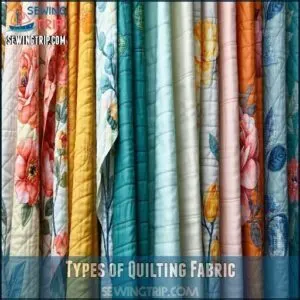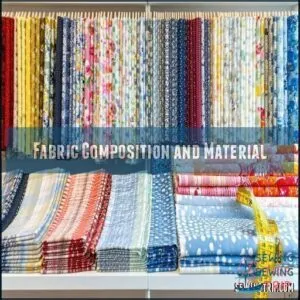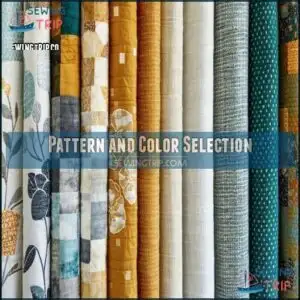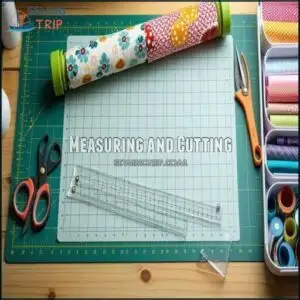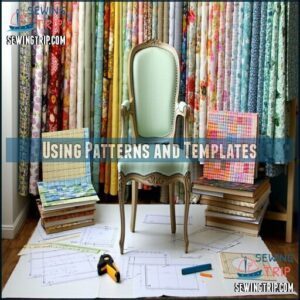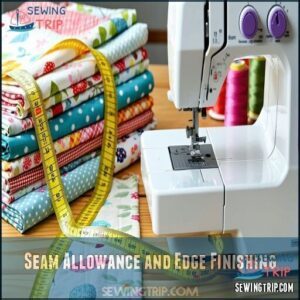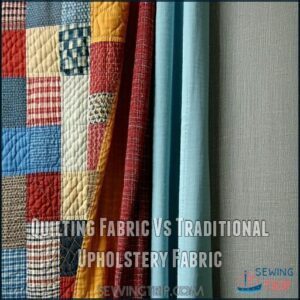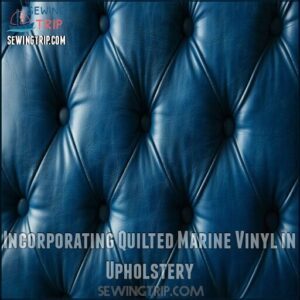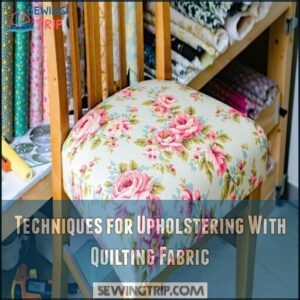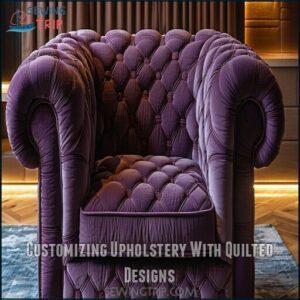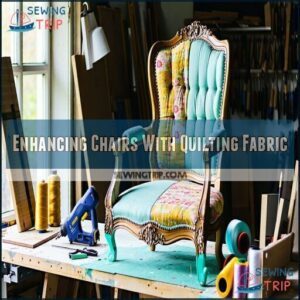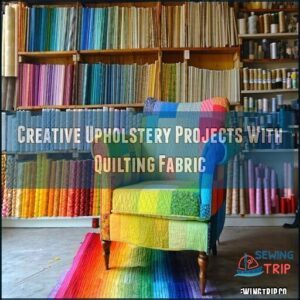This site is supported by our readers. We may earn a commission, at no cost to you, if you purchase through links.
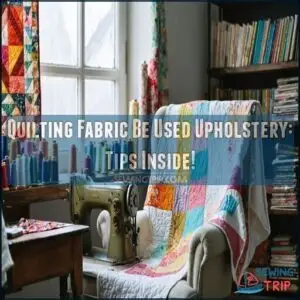 You’re wondering if quilting fabric can be used for upholstery – the answer is yes, you can definitely use it.
You’re wondering if quilting fabric can be used for upholstery – the answer is yes, you can definitely use it.
Quilting fabric offers durability, versatility, and style, making it perfect for upholstery projects.
When choosing quilting fabric for upholstery, consider the type, composition, and pattern.
With the right techniques and tools, you can create unique and comfortable pieces.
Now, you’re probably curious about the best ways to prepare and work with quilting fabric for upholstery, and what benefits it has over traditional upholstery fabric.
Table Of Contents
- Key Takeaways
- Quilting Fabric for Upholstery: Benefits
- Choosing The Right Quilting Fabric
- Preparing Quilting Fabric for Upholstery
- Quilting Fabric Vs Traditional Upholstery Fabric
- Incorporating Quilted Marine Vinyl in Upholstery
- Techniques for Upholstering With Quilting Fabric
- Quilting Fabric Maintenance in Upholstery
- Customizing Upholstery With Quilted Designs
- Enhancing Chairs With Quilting Fabric
- Creative Upholstery Projects With Quilting Fabric
- Frequently Asked Questions (FAQs)
- Conclusion
Key Takeaways
- You can use quilting fabric for upholstery, and it’s a great way to add a personal touch to your furniture, but you’ll need to consider factors like durability, material quality, and design.
- When choosing quilting fabric for upholstery, you should examine the type, composition, and pattern to ensure it’s suitable for your project, and consider factors like thread count, fiber strength, and fabric weight.
- To prepare quilting fabric for upholstery, you’ll need to measure and cut it accurately, use the right tools and techniques, and consider factors like seam allowance and edge finishing to guarantee a professional-looking result.
- Quilting fabric can be a great alternative to traditional upholstery fabric, offering benefits like durability, versatility, and style, but you’ll need to weigh the differences in thickness, texture, cost, and comfort to decide which type of fabric is best for your project.
Quilting Fabric for Upholstery: Benefits

You can use quilting fabric for upholstery, and it offers several benefits, including durability and strength.
Quilting fabric brings durability and strength to upholstery projects
By choosing the right quilting fabric, you’ll find it’s a versatile and practical option for your upholstery projects, providing a unique look and feel.
Quilting fabric offers versatility and practicality for unique upholstery projects
Durability and Strength
When choosing quilting fabric for upholstery, consider:
- Thread Count
- Fiber Strength
- Fabric Weight
- Cotton Blends
- Durability Treatments.
These factors guarantee your quilting fabric is strong and resilient, making it perfect for upholstery projects that require both style and practicality.
Versatility in Design
Exploring quilting fabric for upholstery opens doors to creativity.
You can experiment with pattern mixing, color palettes, and texture variety.
Consider:
- Mixing bold prints with soft linens
- Combining vintage denim with florals
- Pairing rich velvet with crisp cotton
This style adaptability enhances fabric design, allowing you to create unique pieces with quilting fabric for upholstery, reflecting your personal style through fabric combinations and texture variety, and showcasing your ability to mix and match different elements for a unique look that embodies your personal style.
Choosing The Right Quilting Fabric
You’re looking for the right quilting fabric to use for upholstery, and examining factors like durability and material quality is key.
When choosing a quilting fabric, you’ll want to select one that’s suitable for your project, examining factors like thread count, fiber strength, and pattern compatibility.
Types of Quilting Fabric
You’ll find various quilting fabric types, including cotton weaves, synthetic blends, and linen options.
Cotton is soft, while synthetic blends add durability.
Consider fabric durability and types, like silk varieties and novelty fabrics, when selecting quilting fabric for upholstery uses, ensuring the right choice for your project.
Many retailers offer various fabric options for quilting fabric.
Fabric Composition and Material
When selecting quilting fabric for upholstery, consider fabric composition and durability.
- Look for high thread count and strong fiber strength for lasting results.
Cotton blends, like 50/50 cotton-synthetic mix, offer better durability than pure cotton.
Fabric weight affects comfort and wear, so prioritize it.
Synthetic options and cotton blends provide resilience, while high thread count guarantees extra durability.
To guarantee a visually appealing result, consider exploring color theory for lasting results and to achieve a visually appealing outcome.
Pattern and Color Selection
You’re creating visual harmony with quilting fabric for upholstery.
Focus on fabric coordination, balancing bold prints with neutral tones, and consider pattern scale.
Test color schemes under different lighting to verify they complement your space.
Try print mixing for depth and let color psychology guide your choices, guaranteeing functionality and durability.
With thoughtful pattern selection, you’ll achieve a unique personal style, making your upholstery project truly special, and reflecting your taste through effective color schemes and fabric coordination.
Preparing Quilting Fabric for Upholstery
You’re about to prepare your quilting fabric for upholstery, and this is vital.
You’ll need to measure and cut your fabric accurately, considering factors like seam allowance and edge finishing to guarantee a professional-looking result.
Measuring and Cutting
You’re now preparing your quilting fabric for upholstery.
To guarantee accurate measurement, consider these steps:
- Align the fabric grain
- Use sharp cutting tools
- Plan pattern placement
- Add seam allowance
- Measure twice before cutting.
Proper alignment can be achieved using specific alignment tools.
This helps prevent mistakes and guarantees professional-quality results with your quilting fabric, making it perfect for upholstery projects, ensuring a perfect finish.
Using Patterns and Templates
You’re now working with quilting fabric for upholstery, and template design is key.
Use old upholstery as a guide, adding two inches for flexibility.
Consider:
- Durable template materials like cardboard
- Accurate pattern placement
- Scaling patterns to fit your furniture.
This guarantees pattern accuracy and beautiful results.
With custom templates, you’ll achieve professional-looking upholstery, making your quilting projects stand out.
Seam Allowance and Edge Finishing
You’re now focusing on seam allowance and edge finishing, a key step in preparing quilting fabric for upholstery.
To guarantee durability, use a 1/2-inch seam width for standard edges and 5/8-inch for high-stress areas.
| Seam Type | Seam Width | Edge Treatments |
|---|---|---|
| Zigzag Stitch | 1/2-inch | Fray Prevention |
| French Seam | 1/4-inch | Decorative Finish |
| Serging | 1/4-inch | Heavy Wear |
| Binding | 1/2-inch | Curved Edges |
Mastering these techniques will enhance your quilting fabric upholstery projects, making them last longer and look professional with a decorative finish.
Quilting Fabric Vs Traditional Upholstery Fabric
You’re considering using quilting fabric for upholstery, but you want to know how it compares to traditional upholstery fabric.
You’ll need to weigh the differences in thickness, texture, cost, and comfort to decide which type of fabric is best for your project.
Thickness and Texture Differences
You’ll notice quilting fabric has a softer hand and medium weight, while upholstery fabric is heavier and denser.
| Feature | Quilting | Upholstery |
|---|---|---|
| Fabric Weight | Medium | Heavy |
| Hand Feel | Soft | Coarse |
| Drape Quality | Flexible | Structured |
| Layered Look | Yes | No |
| Visual Impact | High | Low |
Cost Considerations
Now that we’ve looked at texture, let’s talk money. Balancing fabric affordability with long-term value is key to smart budgeting.
Quilting fabric, while cheaper upfront, often needs treatments, raising the fabric cost. Upholstery fabric, though pricier, saves on maintenance.
Think of it as DIY savings now versus professional fees later! Consider exploring discount fabric stores for budget-friendly options.
Here’s a quick cost analysis:
| Factor | Quilting Fabric | Upholstery Fabric |
|---|
————-:
————-:
Comfort and Practicality
You weigh comfort and practicality when choosing quilting fabric or traditional upholstery.
Consider the Softness Factor and Breathability Benefits for Everyday Use.
| Feature | Quilting Fabric | Upholstery Fabric |
|---|---|---|
| Softness | High | Low |
| Breathability | Excellent | Poor |
| Maintenance | Easy | Hard |
Incorporating Quilted Marine Vinyl in Upholstery
You’re considering incorporating quilted marine vinyl in your upholstery project, which can add a unique touch to your furniture.
By choosing quilted marine vinyl, you’ll get a durable and water-resistant material that’s perfect for high-traffic areas, and it’s easy to clean and maintain.
Key Features of Quilted Marine Vinyl
You’re considering quilting fabric for upholstery, and now you’re looking at quilted marine vinyl. This material boasts waterproof qualities, UV resistance, and mildew resistance.
It’s perfect for indoor and outdoor settings.
- It resists stains and scratches
- It has a foam backing for comfort
- It’s easy to clean, ensuring it stays fresh and vibrant.
Quilted marine vinyl offers durability, texture options, and cleaning ease, making it a great choice for upholstery projects, especially with its stitch durability and fabric durability.
Applications in Upholstery Projects
You can use quilted marine vinyl for furniture transformation, creating accent pieces, or DIY headboards.
It’s ideal for ottoman upholstery and patchwork furniture, offering durability and style.
Quilting fabric uses extend to upholstery, providing a unique touch to your fabric for furniture projects, ensuring fabric durability in various upholstery fabrics.
Benefits for High-Traffic Areas
For upholstery in busy spots, quilted marine vinyl stands out because of its fabric resilience and wear longevity.
It’s a top pick for high-traffic areas. You’ll find it offers great quilting fabric uses.
Here’s why it rocks:
- Stain Resistance: Spills? No stress! Easy Cleaning is a snap.
- Fade Resistance: Sun’s out? Your colors stay vibrant.
- Wear Layer Protection: It’s built tough, ensuring fabric durability, even with constant use.
Consider Durable Blends for Cost Savings on upholstery fabrics!
Techniques for Upholstering With Quilting Fabric
You’re about to learn various techniques for upholstering with quilting fabric, which will help you achieve professional-looking results.
By mastering stapling and tucking methods, working with corners and curves, and using the right tools, you’ll be able to create beautiful and durable upholstered pieces using quilting fabric.
Stapling and Tucking Methods
You’re ready to staple and tuck your quilting fabric.
A quality staple gun is essential for precision.
| Staple Gun Choice | Tucking Techniques | Tension Control |
|---|---|---|
| Electric | Blind Tucking | Low |
| Manual | Visible Tucking | Medium |
| Pneumatic | Hybrid Tucking | High |
| Automatic | ||
| Semi-Automatic |
Working With Corners and Curves
You’re tackling corners and curves in quilting fabric upholstery.
To master these areas, focus on fabric control with techniques like:
- Mitering corners for crisp edges
- Piping curves for a smooth finish
- Clipping curves to prevent bunching
- Ease stitching for a polished look
Practice makes perfect, so take your time and make small adjustments for flawless results, ensuring fabric durability in your quilting project.
Tools and Equipment Needed
You’ll need the right tools to work with quilting fabric.
| Tool | Purpose | Benefit |
|---|---|---|
| Staple Guns | Secure fabric | Fastening |
| Sewing Machines | Stitch fabric | Durability |
| Measuring Tools | Accurate cuts | Precision |
| Cutting Equipment | Clean cuts | Efficiency |
| Fabric Glue | Bond fabric | Strength |
With these tools, you can master quilting techniques for upholstery, ensuring fabric durability and a professional finish, making your sewing projects successful.
Using the correct upholstery staple remover can make the process easier, and help achieve fabric durability and a professional finish, which are key to making your sewing projects successful with the right tools.
Quilting Fabric Maintenance in Upholstery
You’ll want to keep your upholstered furniture looking its best, so learning about quilting fabric maintenance is vital.
By following some simple tips, you can clean, protect, and repair your quilting fabric upholstery to make it last for years to come.
Cleaning and Stain Removal
You’ll want to act fast when spills happen.
Gently blot with mild soap and warm water to prevent fabric stains.
For tough odors, try baking soda and vacuuming.
Regular deep cleaning maintains stain resistance and vibrancy, while safe cleaning products protect your fabric’s durability, ensuring your quilting fabric upholstery stays fresh and clean.
Regular deep cleaning and the use of safe products are crucial for maintaining the overall appearance and longevity of your upholstery.
Fabric Protection Treatments
To boost fabric durability, consider these fabric protection treatments:
- Stain Resistance
- Water Repellency
- UV Protection
- Fire Retardancy
- Anti-Microbial.
They enhance upholstery fabric resilience, making cleaning easier and extending its life.
A key element is using quality fabric sprays for best results, which involves choosing the right product, testing, and applying evenly for ideal results.
Ensuring your quilting fabric remains vibrant and protected is crucial, and following these steps can help achieve that goal.
Repairing Wear and Tear
How can you keep your quilting for upholstery looking great? Address fabric wear and tear early to extend its life! Quilting fabric can last if you care for it.
- Seam Reinforcement: Fix tears with strong thread.
- Patching Techniques: Cover worn spots with matching fabric.
- Stain Treatment: Clean spills fast to avoid stains.
Use fabric stabilizers, check regularly for fabric durability, and consider preventative measures like stain treatment to prevent future damage and reduce fabric repair.
Customizing Upholstery With Quilted Designs
You can customize your upholstery with unique quilted designs, adding a personal touch to your furniture.
By using embroidery, high-density threads, or CNC quilting, you can create intricate patterns and designs that enhance the overall look of your upholstered pieces.
Embroidery and Pattern Options
You can elevate upholstery with embroidery styles on quilting fabric.
Mix vibrant patterns and stitch designs, choosing embroidery based on fabric compatibility.
Consider pattern scale, fabric matching, and color palettes for a personalized look, ensuring fabric durability and beautiful fabric patterns in your quilting fabric selection and embroidery projects, with a focus on fabric compatibility.
Using High-Density Threads
You’ll often use high-density threads for quilting fabric upholstery.
These threads offer exceptional stitch density and thread strength.
Consider:
- Proper tension adjustment
- Matching needle size to thread thickness
- Consistent thread weight for seam durability.
UV-resistant threads are essential for outdoor applications.
High-density threads enhance fabric durability, especially with cotton blends, and are ideal for detailed embroidery that needs to withstand daily use, ensuring strong fiber strength and tight weave tightness.
CNC Quilting for Precision
You’re taking upholstery to the next level with CNC quilting, leveraging automated technology for precision masterpieces.
CNC accuracy enables perfect stitch consistency, handling complex patterns and digital designs with ease, making it ideal for quilting for furniture and upholstery fabric choices, ensuring fabric durability in the process, which involves precision masterpieces.
Enhancing Chairs With Quilting Fabric
You can enhance your chairs with quilting fabric, which is a great way to give them a fresh new look.
By reupholstering the seats, adding cushion and padding options, and selecting complementary fabrics, you can create a unique and comfortable chair that reflects your personal style.
Reupholstering Chair Seats
You’re reupholstering a chair seat with quilting fabric. Examine the seat frame integrity, then:
- Remove old fabric
- Choose foam density
- Select a staple gun
- Learn fabric attachment methods for durability and fabric durability, considering upholstery fabric choices and fabric for reupholstering.
Cushion and Padding Options
You’re now considering what’s underneath your quilting fabric.
Foam density matters for longevity and comfort.
- High-density foam for everyday seating
- Medium-loft batting for softness
- Down alternatives for a plush feel
Spring systems and fiber fillings vary in thickness and durability, affecting fabric durability and weight.
Selecting Complementary Fabrics
You’re ready to pick fabrics that play nice together.
For a visually balanced look, consider:
- Color harmony
- Texture pairings
- Pattern mixing
- Fabric weight
- Fabric durability
Choose fabrics with complementary texture, color, and pattern to create upholstery that’s both functional and stylish, perfect for home decor, ensuring a beautiful fabric selection with the right fabric texture and weave.
Creative Upholstery Projects With Quilting Fabric
You can create unique and functional pieces by using quilting fabric for upholstery projects, and it’s a great way to add a personal touch to your furniture.
By choosing the right quilting fabric and following some basic upholstery techniques, you can produce professional-looking results that reflect your personal style and creativity.
Designing Unique Upholstered Pieces
You transform furniture into personalized masterpieces with quilting fabric upholstery.
Focus on fabric selection, bold prints, and subtle patterns.
Experiment with color palettes and texture variety for visual interest.
Verify fabric durability ratings for longevity, and explore embellishment options, considering fabric texture, weave, and quilt materials to create unique pieces with visual interest.
Mixed Media and Fabric Combinations
By experimenting with fabric combinations, you create unique upholstery pieces.
Consider mixing:
- Leather and cotton for durability
- Vintage embroidery with modern fabric
- Canvas with quilting details
- Metallic threads for fiber art integration, balancing fabric textures, color palettes, and material weights for design harmony and fabric durability.
Professional Vs DIY Approaches
You’re weighing DIY and professional approaches for your upholstery project.
When using quilting fabric, consider the factors that affect success.
For DIY, you’ll need practice with thick fabrics, basic tools, and a significant time commitment.
In contrast, professionals offer expertise, specialized equipment, and faster completion timelines, but at a higher upfront cost.
A Cost Analysis will help you decide.
Consider Skill Requirements, Time Investment, and Project Complexity to guarantee Quality Control.
Remember, DIY upholstery can be cost-effective, but professionals guarantee results, especially with complex upholstery fabric selection and fabric durability in mind.
Frequently Asked Questions (FAQs)
Can I use any fabric for upholstery?
You can’t use just any fabric for upholstery, as durability and material quality are essential for withstanding daily wear and tear, so choose wisely for a long-lasting result.
Is quilting fabric the same as regular fabric?
You’ll find quilting fabric differs from regular fabric regarding thread count, material quality, and design, making some types more suitable for upholstery projects than others, actually.
Can you use quilting fabric for clothing?
You can use quilting fabric for clothing, but consider its weight, durability, and suitability for the garment type, as some quilting fabrics may not be ideal for wearable items.
How do I know if fabric is suitable for upholstery?
You’ll know fabric is suitable for upholstery if it’s durable, has a high thread count, and sturdy fibers, making it perfect for withstanding daily wear and tear easily.
Can you use a quilt to reupholster a chair?
You can repurpose a quilt to reupholster a chair, but consider the quilt’s durability, fabric type, and potential wear, ensuring it’s suitable for the chair’s intended use and traffic.
Can you use any fabric for upholstery?
Like a puzzle, you’ll discover not all fabrics fit upholstery, requiring durable materials like cotton or leather for a perfect match.
Can you use quilting fabric for garments?
You can use quilting fabric for garments, but consider the fabric’s weight, durability, and suitability for the intended clothing item, as some quilting fabrics may not be ideal.
How to fix upholstery with quilting fabric?
You’ll carefully select durable quilting fabric, measure, cut, and sew it onto your furniture, ensuring a snug fit to fix upholstery with a fresh, stylish look.
What are quilting fabrics durability limitations in upholstery?
You’ll find quilting fabrics have durability limitations in upholstery, such as prone to staining, grime buildup, and potential for wear and tear, requiring treatments for added strength.
Can quilting fabric replace leather in upholstery projects?
You can replace leather with quilting fabric in upholstery projects, but consider durability and maintenance, as quilting fabric may not be as resilient as leather.
Conclusion
Now you’re a pro at using quilting fabric for upholstery.
You’ve learned it’s possible to use quilting fabric be used upholstery, and it offers great benefits.
Go ahead, get creative with quilting fabric be used upholstery projects, and have fun making unique pieces that showcase your style and skill with quilting fabric be used upholstery.
- https://midwestfabrics.com/blogs/recent-posts-on-our-blog/upholstery-tools-amp-supplies-for-every-upholstery-project?srsltid=AfmBOoq9qDX6WSkHIArLMysxD6ho8UqFDVeh7UmRyb6Mj2k1apCjjgYo
- https://homesewingdepot.com/collections/upholstery-tools?srsltid=AfmBOopTpXjuQGq5Wolaol4Gra1vpqdRS3C3WacMpbJ-Ln9PFrXQJtTV
- https://m.youtube.com/watch?v=_J86l2z4an8
- https://www.youtube.com/watch?v=KWuOnR7EUMs
- https://food52.com/blog/27371-best-diy-upholstery-tools?srsltid=AfmBOorbXNFVgN89ajS8Bhi7YB_mCxAnw6trz-KDgrLny-zEHatJu-8w

